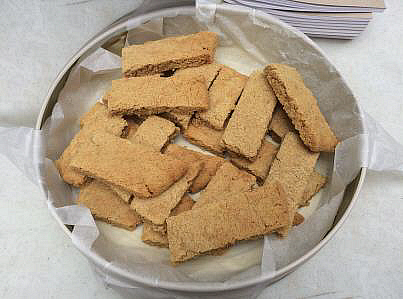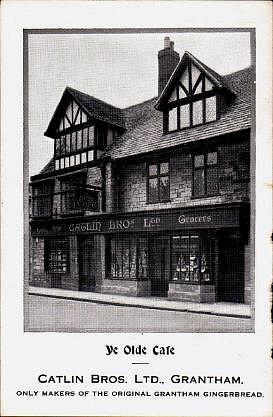

|
 Round, pale, domed biscuits made with white wheat flour, egg, white sugar and slightly raised with soda. Distinctively ‘white’ from being sweetened with white sugar, rather than with treacle.  Image: hawkensgingerbread.com  Original Receipt from Nottingham Evening Post – Friday 11 September 1925 Original Receipt from Nottingham Evening Post – Friday 11 September 1925E. M. A – Here is a recipe for Grantham Gingerbread: 2lb of flour, 3 1/2 oz of butter, 1 1/2 lb of sugar, 1 oz ginger, half cup milk, 1/2 oz volatile salts. Melt butter and sugar and mix altogether. Bake in moderate oven.  Finger-form Grantham Gingerbread Image: Alex Bray  Original Receipt from Grantham Journal – Friday 31 August 1951 Original Receipt from Grantham Journal – Friday 31 August 1951Oakham recipe for the Grantham Gingerbread A recent article in the “Journal.’ headed “Grantham Gingerbread: Is this the secret recipe?” has drawn the comment from 84-years-old Mrs. E. J Ellingworth. of 14, Melton road, Oakham, that it is not: Carefully opening her old family recipe book, which dates back over 100 years Mrs. Ellmgworth read the following ingredients for the white “Grantham Gingerbread”: 1 lb. of flour: 1 1/2 lb. of powdered sugar: 1/2 lb. of butter; 1 oz. of ground ginger: 1 teaspoonful of bicarbonate of soda: and one egg. Instructions for cooking are; Rub the butter well into the flour, add the sugar with beaten egg. rub well together for 10 minutes, and then bake in a slow oven for 10 minutes. When cooked, said Mrs. Ellingworth. the gingerbread should have risen, leaving the inside hollow. While looking through this treasure book. Mrs Ellingwonh came across the following recipe for the now non-existent “Feast cake.” which she says was baked by everyone for the Oakham Feast Sunday celebrations on September 9th each year; “2 1b. of flour; 1/2 lb. of brown sugar; 1 lb, currants; 1 1/2 lb. of lard: 3 oz of lemon kali: one nutmeg: 2 oz. of lemon peel. Mixed with water, it was baked In the normal way. This recipe brought back to her mind some interesting recollections of Feast Week celebrations of days when, she said, there there were some real “happenings” in the form of sports, etc. Her father-in-law was the Town Crier. We’re hugely obliged to Jane Jones for this excerpt from the notebooks of her grandmother Florence ‘Floss’ May Bools (née Heppenstall) who was born in 1902 in Barrowby Lincolnshire:  The tale is that Grantham gingerbread arose when a baker in the 1740’s mistook one ingredient for another in attempting to make Grantham Whetstones. Long associated with fairs, and commercially manufactured by several bakers, they remain virtually unknown outside their home region. Grantham Journal – Saturday 23 December 1922  c1950 See: Gingerbread  |
|
MORE FROM Foods of England... Cookbooks ● Diary ● Index ● Magic Menu ● Random ● Really English? ● Timeline ● Donate ● Royalty ● English Service ● Food Map of England ● Lost Foods ● Accompaniments ● Biscuits ● Breads ● Cakes and Scones ● Cheeses ● Classic Meals ● Curry Dishes ● Dairy ● Drinks ● Egg Dishes ● Fish ● Fruit ● Fruits & Vegetables ● Game & Offal ● Meat & Meat Dishes ● Pastries and Pies ● Pot Meals ● Poultry ● Preserves & Jams ● Puddings & Sweets ● Sauces and Spicery ● Sausages ● Scones ● Soups ● Sweets and Toffee ● About ... ● Bookshop ● Email: [email protected] COPYRIGHT and ALL RIGHTS RESERVED: © Glyn Hughes 2022 BUILT WITH WHIMBERRY |